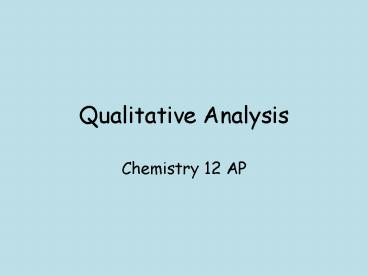Qualitative Analysis PowerPoint PPT Presentation
1 / 19
Title: Qualitative Analysis
1
Qualitative Analysis
- Chemistry 12 AP
2
What is Qualitative Chemical Analysis?
- It is a branch of chemistry that deals with the
identification of elements or grouping of
elements present in a sample. - There are usually two types qualitative
inorganic analysis and qualitative organic
analysis.
3
Identifying Ions
- We could use these rules to work out if
hydroxides or chlorides are present in a
solution. (What is one difference between the two
ions?) - To make life easier we could use a flow chart
that shows the order that we need to do tests in
order to eliminate possible ions - These two flow charts divide all ions into two
groups anions and cations. Once we have
identified one of the ions in a solution we need
to identify the other. Can also use flame tests
(for soluble metals), or other tests (see next
page).
4
- Chemical tests are used to confirm that some
anions (negative ions) or cations (positive ions)
are present in an unknown, also to identify
unknown gases or liquids. - If you made a chemical reaction that produces
fumes or gases or something you must have a way
to identify this produced gas or fumes.
5
Flame Colours of Solutions
- If a flame test produces one of the these
colours, that ion is in the solution. Other
colors are possible, but these are the most
common.
6
(No Transcript)
7
(No Transcript)
8
(No Transcript)
9
Identifying Cations NH4, Na, Mg2, Ag,
Fe2, Fe3, Cu2, Al3, Pb2, Zn2, Ba2
litmus stays red Na
add 2 drops of dilute NaOH solution.
add NaOH solution, heat, test gas with red litmus.
no precipitateNH4, Na
litmus goes blue NH4
add excessNaOH solution
precipitate disappearsAl3, Zn2, Pb2
white precipitate formsAl3, Zn2, Pb2,
Mg2, Ba2
new sample
precipitate remainsMg2, Ba2
add 2 drops, thenexcess NH3 solution
new sample
add dilute H2SO4 solution
white precipitate forms and disappears, Zn2
colourless solutionMg2
white precipitateBa2
white precipitate formsAl3, Pb2
new sample
add dilute H2SO4 solution
green precipitate formsFe2
white precipitatePb2
colourless solutionAl3
new sample
orange precipitate formsFe3
add 2 drops KSCN solution
dark red solution confirms Fe3
new sample
blue precipitate then deep blue solution Cu2
add 2 drops, then excessNH3 solution
blue precipitate formsCu2
new sample
brown precipitate then colourless solution Ag
add 2 drops, then excessNH3 solution
brown precipitate formsAg
10
Identifying Cations I
- Use the cation flowchart to identify the cation
used below
Add NaOH
Add KSCN
11
Identifying Cations II
- Use the cation flowchart to identify the cation
used below
Add NaOH
Add NH3
12
Identifying Anions CO32?, Cl?, I?, S?2,
SO42?, NO3?, OH?
bubbles of gasCO32?
add dilute HCl solution
litmus goes blueOH?, CO32?
START add red litmus
no bubblesOH?
Smelly bubblesS?2
litmus remains redSO42?, Cl?, I?, NO3?
white precipitateSO42?
add Ba(NO3)2 solution
no precipitate
new sample
precipitate disappearsCl?
add dilute NH3 solution
add AgNO3 solution
precipitateCl?, I?
precipitate remainsI?
no precipitateNO3?
13
Identifying Anions I
- Use the anion flowchart to identify the anion
used below
Add Ba(NO3)2
Add AgNO3
Add NH3
Add red litmus
14
Identifying Anions II
- Use the anion flowchart to identify the anion
used below
Add HCl
Add red litmus
15
Solution Colors
Cations Ions Symbol Colour
Cations Chromium(II) Copper(II) Cr2 Cu2 Blue
Cations Chromium(III) Copper(I) Iron(II) Nickel(II) Cr3 Cu Fe2 Ni2 Green
Cations Iron(III) Fe3 Pale yellow
Cations Cobalt(II) Manganese(II) Co2 Mn2 Pink
Anions Chromate CrO42- Yellow
Anions Dichromate Cr2O72- Orange
Anions Permanganate MnO42- purple
16
Some Precipitate Colours
- Al3, Mg2,Ca2 ? white
- Cu2 ? blue/green
- Fe2 ? grey/green
- Fe3 ? red/brown
Precipitated calcium carbonate (CaCO3)
Precipitated copper(II) hydroxide, Cu(OH)2
17
So How Do I Use Qualitative Analysis?
- Here is an example of a question
- A sample of a solution of an unknown was treated
with dilute HCl. The white precipitate formed was
filtered and washed with hot water. A few drops
of KI solution were added to the hot water
filtrate and a bright yellow precipitate was
produced. The white precipitate remaining on the
filter paper was readily soluble in NH3 solution.
What two ions could have been present in the
unknown?(A) Ag and Hg22(B) Ag and Pb2(C)
Ba2 and Ag(D) Ba2 and Hg22(E) Ba2 and
Pb2
Ask yourself what happens at each step?
Solution Ag forms a precipitate with chlorides
(AgCl), so what is the other metal? Think of a
metal that would likely be insoluble with I- ?
Pb2 is a good choice because in our labs, it
formed mostly yellow/orange precipitates.
18
Lab Procedures For Qualitative Analysis
- Solution containing ions of all cation groups
filtration
Precipitates AgCl, Hg2Cl2, PbCl2
HCl
Solution containing ions of remaining groups
filtration
Precipitates CuS, CdS, HgS, SnS, Bi2S3
H2S
Solution containing ions of remaining groups
filtration
Precipitates CoS, FeS, MnS, NiS, ZnS, Al(OH)3,
Cr(OH)3
NaOH
Solution is now basic, so other S2- will
precipitate
Solution containing ions of remaining groups
filtration
Precipitates BaCO3, CaCO3, SrCO3
Na2CO3
Solution contains Na, K, NH4 ions
19
Questions for Practice
- We will be completing a lab very shortly with the
techniques for qualitative analysis. - To assist you in this lab, the following
questions should be completed - Chang Text pg. 742 16.79, 16.81, 16.82
- Pg. 158 4.24

